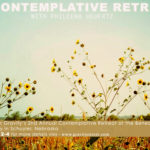An Interview with Phileena Heuertz :: by Jamie Arpin-Ricci :: on ‘A Living Alternative Our Missional Pilgrimage’
Living & working in the context I do, the hard work of missional community & activism with the marginalized lives in difficult tension with the need to a life of disciplined spirituality, of contemplation. It is, perhaps, the single deepest challenge I face in my role in community. That is why Phileena Heuertz’s new book “Pilgrimage of a Soul: Contemplative Spirituality for the Active Life” is a powerful gift to the Body of Christ. Speaking beautifully, personally & authoritatively from her own experience, Phileena manages to write a book that will speak to the inactive contemplative and the un-contemplative activist. In other words, it speaks to every Christians.
In case you haven’t heard of Phileena (and if you haven’t, get familiar with her, because she is an important voice in the Church today), here is her brief bio from IVPress:
Phileena Heuertz is one of the leading directors of Word Made Flesh (WMF)–an international community serving Christ among the most vulnerable of the world’s poor.
Over the years, Phileena has traveled through nearly 70 countries working with marginalized and oppressed people–abandoned children, victims of HIV and AIDS, sexually exploited women and children, people recovering from drug addictions, children who live on the streets, refugees and children of combat and war.
Since 1995, Phileena has served WMF through child advocacy, community care and leadership development. In 2004 she founded the Community Care Center-one of the internal support offices for the international movement. Phileena believes that union of action and contemplation is crucial to ongoing personal transformation, healthy community life, and sustainable, authentic social justice efforts. Phileena’s responsibilities require her attention in the international office in Omaha, Nebraska, as well as in the WMF communities across the globe.
“Pilgrimage of a Soul” is another gem from IVPress (who sent me the book gratis) in their Likewise Books imprint. I had the privilege to interview Phileena about the book, so hear what she has to say in her own words. Then order the book today!
Jamie Arpin-Ricci: The subtitle of your book is “Contemplative Spirituality for the Active Life”. For some people this might seem like an odd fit. Why do you think it is so critical to bring these two dynamics together?
PH: It is critical to bring together contemplation and action because one purifies and authenticates the other. True contemplation will necessarily bear fruit in activism. Faith without works is dead.
JAR: You decided to explore this topic in a very personal way. Why did you choose to do so through storytelling? How will this change the experience for the reader?
PH: Using narrative of my sabbatical year—making pilgrimage in Spain and then in solitude at Duke has a way of making very deep and in some ways abstract spiritual truths more concrete and tangible for the reader.
JAR: Many Christians, while inspired by the life you have followed Christ into, might feel that they will never live the kind of life you lead. While I don’t need convincing, convince those readers what you book has to offer them.
PH: POAS will invite the reader to reflect on their personal journey and unfolding life story. The message of the book is inviting the reader into living their life authentically.
JAR: Can you very briefly explain the seven movements outlined in the book?
PH: Awakening, Longing, Darkness, Death, Transformation, Intimacy and Union are seven movements that I’ve experienced in my personal spiritual journey. I believe these movements of the soul are universal to those who are attentive to them, and they support ongoing Christian conversion and growth. These movements can certainly be found in the Scriptures, but when they are personally acknowledged and experienced, we are on our way toward living the abundant life of which Jesus so often spoke. Though we can know about these movements, the better is to experience them. Experiential knowledge is the greatest knowledge. We can argue and debate head knowledge. But who can dismiss what one experiences?
Pilgrimage of a Soul attempts to help us connect our head to our heart that we might be more aware of and experience more of the living God.
These seven movements or signposts in the journey are not really linear but more circular in nature. We could be in and out of one movement in almost any order. The spiritual journey is not so much about progressing from one point to another as it is about surrendering to ongoing transformation and union with God. These seven movements support us in that objective; and though these experiences are quite internal and symbolic, they have very concrete, external expressions in our daily life—this is the place where contemplation meets action.
To try and summarize these, “Awakening” is the point in our journey when we see more clearly particular illusions in our life—more specifically—parts of our false self that we had previously been asleep to.
“Longing” symbolizes the discontentment in us that desires more—more connection to God, self, others and the world in which we live.
“Darkness” and “Death” are the necessary experiences to bringing forth new life that we most often resist. Ancient Christian mysticism has always affirmed the gift of darkness that essentially clouds our senses of the consoling presence of God that we might be purified and grow in the spiritual faculties that relate to God on a deeper level.
Death is the experience of final surrender to the illusion(s) we’ve awakened to. Though the illusory false self is just that—an illusion—our identity clings to it all the same. To let go of it is frightening because it’s all we’ve known and we are less acquainted with the true self (if acquainted at all). So there is no comfort in what is coming—it is too unknown to us. Death (in the spiritual journey and the final material death when our body dies) is the ultimate act of faith because it is a final gesture of trust and love in the One who is greater than us and knows us better than we know ourselves. By surrendering to death of our illusions, we trust that new life—resurrection—will come, though we have no concrete guarantee of it.
“Transformation” then is that long, hoped-for new life. Transformation is the period of living into greater truth; living into greater awareness of the true self.
“Intimacy” is the experience of growing deeper in love with God, self, others and the world. Anxieties, turmoil, defense mechanisms, pretensions and pathologies that previously plagued us have been settled, healed and we are freer to know (God, self, others, the world) and be known (by God, self, others, the world).
“Union” is the experience of the fragmented parts of ourselves (identity, confused perceptions of God, broken relationships, misaligned vocation) coming together. In union we experience these previously broken places now restored, redeemed, made whole. We experience greater centeredness in the love of God—which permeates all of our life actions.
JAR: Was there anything in the book you wanted to include, but couldn’t? Tell us about it.
PH: Interesting question! Actually I’m very satisfied with the content of the book. There wasn’t anything I wanted to include that was edited out. David Zimmerman, my editor at IVP, was really committed to ensuring my voice, heart and desires for the book came through during the editing process.
JAR: David is my editor as well and that has been my experience with him as well, so that is encouraging! Tell us something odd & unique about yourself that few people would know about.
PH: So funny! I tend to be an open book—especially now with the release of a very intimate unveiling of my life in POAS. Hmmm odd and unique? You’ve really stumped me. Maybe you should ask my husband!
JAR: Thanks Phileena.



